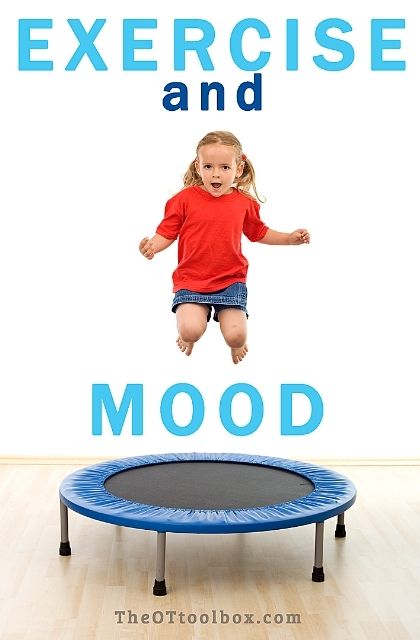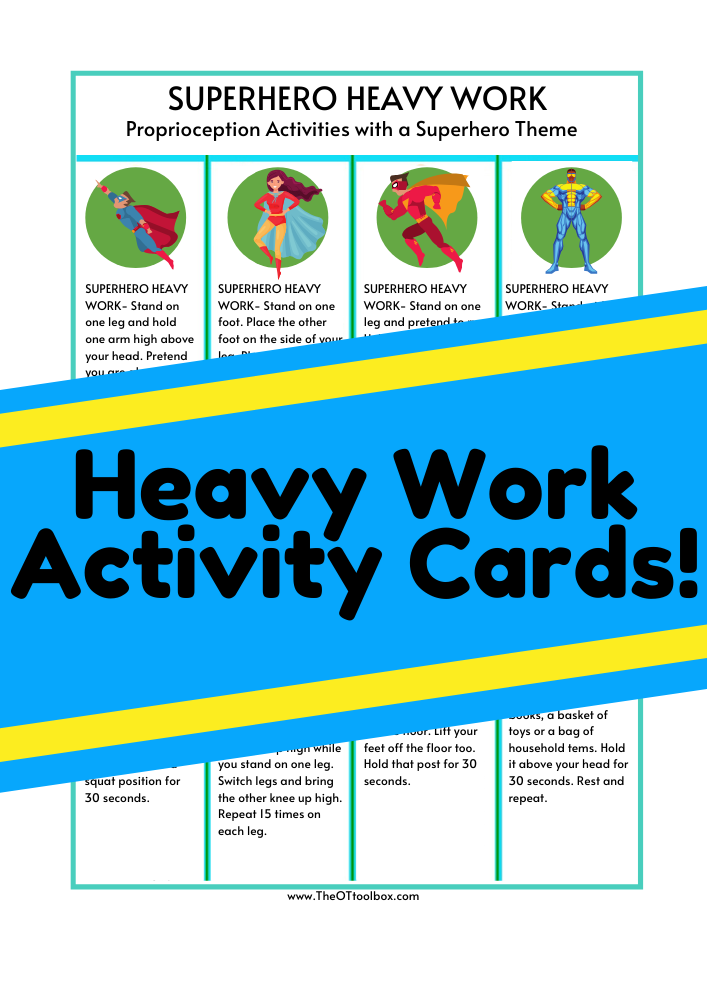Years of research and personal experience can tell us that adults tend to function better with regular exercise. Exercise helps us sleep better, reduce our stress, and manage our weight2. But what about our kids – how do they benefit from exercise? Today we are going to dive deep into the research and see why and how our kids should exercise to better their mood. Let’s look at the link between exercise and mood, and establishing healthy habits that lead to function and independence in kids.
Related: Emotional Regulation and Executive Functioning Skills.

Exercise and Mood: Managing TEMPER TANTRUMS
If your child is having issues with emotional regulation, it may come out as a temper tantrum. You know the feeling of having no control over your emotions; being taken on a ride of sadness, aggression, and pounds of heavy frustration. Most adults have had enough practice honing their emotional regulation skills to keep them from screaming in the middle of the grocery store after a long day. Children, however, are still working on developing emotional regulation skills, and because of that, their overall mood can suffer.
Also related is the mood of those around us, or co-regulation. This is another aspect of mood that we don’t always first think of as it relates to our behavior and actions.
According to research new and old, exercise can help a child better regulate their mood9. Next time your child is screaming in the middle of Target, think to yourself – have they gotten enough physical activity recently? I have found that 30 mins of exercise in the morning can help even out moods for the whole day. Plus, you are bound to get a good nap time out of them if they have gotten enough physical activity – double whammy for everyone’s mood!
Tips for Exercise and Mood
Try these tips for encouraging exercise to reduce tantrums in toddlers:
- Instead of pushing your toddler in a scroller on neighborhood walks, encourage them to walk next to you for a while.
- Use classic movement songs to incorporate movement into their day – our favorites are “Animal Action” By Greg and Steve, “Jim Along Josie” By Pete Seeger, and “Pet Parade” by Hoyt Axton.
- If screen time is a part of your routine, use videos like Cosmic Kids Yoga to make the screen time more valuable.
Exercise to REDUCe ANXIETY AND DEPRESSION
Research shows that regular exercise in youth can treat anxiety and depression in the short term and long-term 3,4. Some studies suggest that high-intensity exercises, that will increase cardiorespiratory activity, improve mood more than low-impact exercises, like yoga5.
While there is lots of evidence to support that exercise can improve mood in both adults and children, some of the research points to other affects that exercise programs can have on children. For example, when children are enrolled in sports or other physical activity programs, they are also socially active and get attention from adults, which may also positively impact their mood7.
Whatever way you look at it, exercise is likely to improve their mood and guard against anxiety and depression.
Exercise for self-CONFIDENCE
One way that exercise improves mood is through raising self-esteem – physical activity gives you a confidence boost! Research shows that all kinds of physical activity contribute to a rise in self-esteem5.
Self-esteem is so important in all the occupations that children have, particularly in school. Academic and social success are partially dependent on self-esteem and self-worth, and both contribute to a positive mood.
“Psychological and behavioural problems in children and adolescents are common, and improving self‐esteem may help to prevent the development of such problems” (Ekeland et al., 2004).
Exercise and positive BEHAVIORS
In one study, researchers found that teachers reported an increase in wanted behaviors for children enrolled in both high and low-intensity exercise programs5. The theory here is that when a child’s physical activity needs are met, they are better able to regulate their emotions, attention, and behaviors9.
This comes with the awesome effects that exercise has for executive functioning, which controls many cognitive abilities6. With this increase in desirable behaviors, they will be more likely to develop positive relationships with their peers, teachers, and family members8.
“Exercise…is highly relevant in preadolescent children… given the importance of well-developed executive functions for daily life functioning” (Verburgh et al., 2014).
Exercise has been shown to increase self-esteem, cognition and academic success, and decrease depression and anxiety in children3. Not to mention the obvious health factors associated with physical activity like heart and respiratory function. All said, exercise is integral to the overall health and wellness of our children.
EXERCISES FOR KIDS
After all that exercise talk, we have to offer some great ideas to add to your list! Most important to any exercise routine – you have to do what you love! Find what your kids like and encourage them to try new activities.
- Alphabet Exercises
- Therapy Band Exercises for Kids
- Pediatric Fitness from the American Heart Association
- Fun Indoor Games to Burn Energy
Another key strategy to encourage exercise in kids is to model healthy habits as the child’s parent. When parents model healthy choices, fitness, and regular exercise, kids see that and are more likely to follow suit with their own healthy choices.
One way that adults can model healthy choices is through exercising in the home. When kids see adults exercising, they have that positive interaction with physical activity.
Having a treadmill in the home is one sure-fire way to encourage movement, exercise, and healthy habits that are integrated into the day-to-day. With Horizon Fitness treadmills and fitness equipment, you get the availablity of cardio equiptment right in the home. It’s there as a visable option for adding movement and regular cardio exercise on a daily or weekly basis.
Plus, parents of children can benefit from the fitness programs for quick and effective workouts that fit into the busy family’s schedule. Horizon offers a number of entertainment apps and streaming options, including Bluetooth speakers, live or on-demand fitness apps, and other streaming fitness opportunities. All of these extras are designed to promote improved physical exercise and meaningful motivation.
Click here to join me in using Horizon Fitness equipment as a tool to ensure healthy families.
References
1. Ekeland, E., Heian, F., Hagen, K. B., Abbott, J. M. & Nordheim, L. (2004). Exercise to improve self‐esteem in children and young people. Cochrane Libary of Systematic Reviews. https://doi.org/10.1002/14651858.CD003683.pub
2. Oaten, M. & Cheng, K. (2010). Longitudinal gains in self‐regulation from regular physical exercise. The British Journal of Health Psychology,11(4). https://doi.org/10.1348/135910706X96481
3. Ortega, F. B., Ruiz, J. R., Castillo, M. J. & Sjöström, M. (2008). Physical fitness in childhood and adolescence: a powerful marker of health. International Journal of Obesity, 32, 1–11. https://doi.org/10.1038/sj.ijo.0803774
4. Pascoe, M. C. & Parker, A. G. (2018). Physical activity and exercise as a universal depression prevention in young people: A narrative review. Early Intervention in Psychiatry, 13(4). https://doi.org/10.1111/eip.12737
5. Telles, S., Singh, N., Bhardwaj, A. D., Kumar, A. & Balkrishna, A. (2013). Effect of yoga or physical exercise on physical, cognitive and emotional measures in children: a randomized controlled trial. Child and Adolescent Psychiatry and Mental Health,7(37). https://doi.org/10.1186/1753-2000-7-37
6. Verburgh, L., Königs, M., Scherder, E. J. A., & Oosterlaan, J. (2014). Physical exercise and executive functions in preadolescent children, adolescents and young adults: a meta-analysis. British Journal of Sports Medicine,48, 973-979. https://bjsm.bmj.com/content/48/12/973
7. Williams, C. F., Bustamante, E. E., Waller, J. L. & Davis, C. L. (2019). Exercise effects on quality of life, mood, and self-worth in overweight children: the SMART randomized controlled trial. Translational Behavioral Medicine,9(3), 451–459. https://doi.org/10.1093/tbm/ibz015
8. Xue, Y., Yang, Y. & Huang, T. (2019). Effects of chronic exercise interventions on executive function among children and adolescents: A systematic review with meta-analysis. British Journal of Sports Medicine,53, 1397-1404. doi:10.1136/bjsports-2017-097600
9. Zhang, Y., Fu, R., Sun, L., Gong, Y., & Tang, D. (2019). How does exercise improve implicit emotion regulation ability: Preliminary evidence of mind-body exercise intervention combined with aerobic jogging and mindfulness-based yoga. Frontiers in Psychology,10. doi: 10.3389/fpsyg.2019.01888

Sydney Thorson, OTR/L, is a new occupational therapist working in school-based therapy. Her
background is in Human Development and Family Studies, and she is passionate about
providing individualized and meaningful treatment for each child and their family. Sydney is also
a children’s author and illustrator and is always working on new and exciting projects.
Exercise and Mood Resources for Kids
You’ll love these resources designed to help kids get moving, exercising, and building skills, and kids won’t even realize they are “exercising”!
Designed to use fun themes, these heavy work activity cards add proprioceptive input to help kids become more aware of their body’s position in space.
Heavy work input allows kids to gain more awareness of motor planning skills, coordination, AND strengthening in fun and creative ways.
Incorporate the themed exercise cards into learning themes or play.
Grab your set of heavy work exercise cards, now.
Includes themes:
- Trucks Heavy Work Activities
- Insects Heavy Work Activities
- Sea Animals Heavy Work Activities
- Farm Animals Heavy Work Activities
- Jungle Animals Heavy Work Activities
- Woodland Animals Heavy Work Activities
- Superheroes Heavy Work Activities
- Sports Heavy Work Activities
- Monsters Heavy Work Activities
- Summer Heavy Work Activities
- Butterfly Life Cycle Heavy Work Activities



